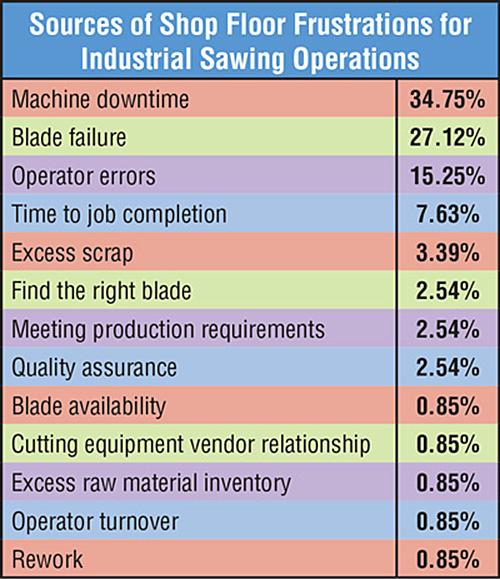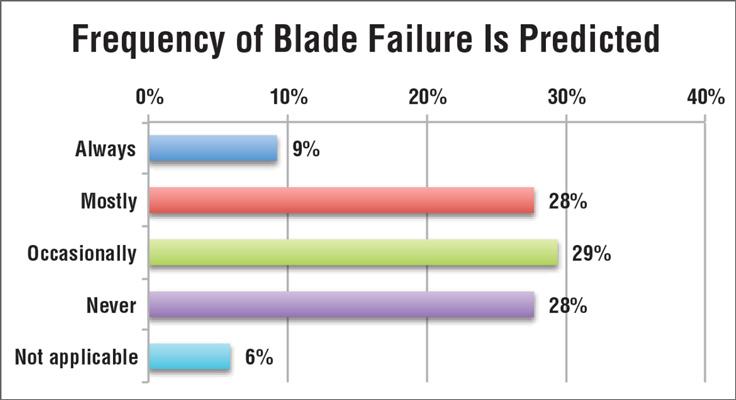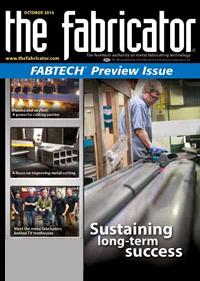Director of Marketing
- FMA
- The Fabricator
- FABTECH
- Canadian Metalworking
Categories
- Additive Manufacturing
- Aluminum Welding
- Arc Welding
- Assembly and Joining
- Automation and Robotics
- Bending and Forming
- Consumables
- Cutting and Weld Prep
- Electric Vehicles
- En Español
- Finishing
- Hydroforming
- Laser Cutting
- Laser Welding
- Machining
- Manufacturing Software
- Materials Handling
- Metals/Materials
- Oxyfuel Cutting
- Plasma Cutting
- Power Tools
- Punching and Other Holemaking
- Roll Forming
- Safety
- Sawing
- Shearing
- Shop Management
- Testing and Measuring
- Tube and Pipe Fabrication
- Tube and Pipe Production
- Waterjet Cutting
Industry Directory
Webcasts
Podcasts
FAB 40
Advertise
Subscribe
Account Login
Search
Improving metal cutting productivity
Focus on continual measurement of the sawing operation, proactive machine maintenance, and ongoing training for operators
- By Matt Lacroix
- October 15, 2014
- Article
- Cutting and Weld Prep

By identifying and addressing new opportunities for production efficiency in key operations, such as sawing, metal fabricators can ensure that their shop floor activities continue to meet customer demand and improve the bottom line.
Having survived the Great Recession and built their businesses back up to 2007 levels, metal fabricators realize they need to pursue operational efficiencies that allow them to stay on top of more business opportunities, while simultaneously making smart investments. This is more than just a desire to control costs; it’s a push to make strategic decisions that lead to sustainable practices that maximize machine uptime—which translates into bigger profit margins.
The LENOX® Institute of Technology conducted a survey in mid-2013 that explored opportunities where companies could find that additional productivity on the shop floor. The survey of more than 100 industrial metal cutting operations revealed that attending to internal process improvements, measuring and examining administrative and floor processes, and making changes that are not related to technology can result in more parts out the door on time and at a larger profit margin. (The survey focused primarily on organizations that use saws to cut metal. Laser cutting machines and waterjets were not included in this study. Metal fabricators at 37 percent, metal service centers at 29 percent, and machine shops at 18 percent made up the bulk of the survey respondents.)
Just look at the top three sources of frustration for industrial metal cutting operations: machine downtime, blade failure, and operator error (see Figure 1). These factors remain impediments to operational improvement even though the general trend in industry is to focus on those types of process improvements.
Metal fabricating operations find themselves in a race to stay on top of orders. Any reason to stop a machine becomes a bad reason. The reality is that the machine ultimately will stop, but it will do so at an unexpected time. The secret is to plan ahead for maintenance and perform it in a controlled manner—avoiding the headaches of an unexpected machine shutdown and unplanned downtime.
More specifically, metal fabricators can take action in these areas:
- Smarter, more predictive operations management
- Proactive maintenance of saws and blades
- Ongoing operator training
Predict Downtime
Predictive operations management falls into two categories: business management systems and machine-level operations.
The first category includes systems that provide the information to help businesses adjust management approaches to meet future expectations. An example is enterprise resource planning software. These sophisticated systems allow companies to plan their jobs better, execute what they need to do more efficiently, and get the job out the door fast.
The second category is operations at the machine level, which includes the setting and adhering to equipment maintenance schedules. That’s where predictable downtime comes into play. With 73 percent of the survey respondents reporting saw uptime greater than 75 percent (see Figure 2), stopping production for scheduled maintenance has to prove that it pays back.
Taking a proactive maintenance stance by shutting a machine down to check on wear parts, topping off fluids, and making sure the machine is running optimally helps a company get the most out of the machine and the blade. It makes the life of the operators and maintenance crew easier. In short, predictive downtime is less disruptive to the production cycle.
To illustrate the point, think of a personal vehicle. After purchasing it, the owner can run it with little to no regard to maintenance. Eventually it is going to break down. But provide preventive maintenance—like regularly changing the oil, fluids, and brake pads—and it keeps running and won’t leave the owner without transporation.

Figure 1
According to the “Benchmark Survey of Industrial Metal-
Cutting Organizations,” the top three sources of frustration
on the shop floor can be addressed with a more disciplined
approach to planned maintenance and formal operator
training.
A few hours of scheduled maintenance can prevent unanticipated downtime that otherwise can keep equipment out of commission for days while the problem is identified. With scheduled maintenance, parts are ordered and ready to go; any repairs are made in a timely manner.
The metal cutting survey found that 67 percent of operations that follow scheduled and planned machine maintenance also reported year-over-year improvements in job completion rates. A large percentage of those companies also said they could usually predict blade failure and make replacements before the part quality was affected or the blade broke (see Figure 3).
Companies implementing predictive maintenance consisted of both large and small operations. Typically, larger companies with several operations, such as band and circular sawing, drilling, and turning, frequently have their own maintenance staffs. Smaller companies typically rely on suppliers to provide maintenance as part of value-added service packages. In the end, company size is not an excuse to ignore the potential impact of predictive operations management.
Make Time for Maintenance
Scheduled maintenance for equipment and blades needs to be viewed in the context of operational impact. Time used to monitor and tweak machine and blade performance can have a substantial effect on production efficiency and on-time delivery, particularly in high-production shops.
For example, if a saw lacks a routine maintenance schedule, it can start to slip from a performance standpoint. Saw vibration can increase as certain parts start to wear. That vibration can transfer to the blade and diminish its performance and life. As a result, it drives up scrap and tooling costs.
In another example, saw blades need to be broken in if they are to have a long operational life (see Figure 4). It may sound like counterintuitive thinking, but slowing production to break in a new blade actually adds to both productivity and blade life.
How much of an impact does proper blade break-in make? Seventy percent of the metal cutting survey respondents who said scrap and rework costs are less than 5 percent also said that they always break in their band saw blades (see Figure 5). By breaking in blades properly, organizations are able to reduce “soft” failures—not like equipment breakdowns—that lead to waste and scrap, both of which eat at the bottom line.
Those organizations willing and able to invest in the latest cutting equipment may find some machines that are actually programmed to run the break-in process for the operator. Of course, most machines don’t offer that; it’s on the operator to adjust the band speed and the feed rate to get it right. In those situations, ongoing operator monitoring, coupled with instruction and coaching, can have a direct benefit on industrial metal cutting operations.
Invest in People
Anecdotal information and some industry research suggest that CEOs in metalworking companies are disproportionately not investing in people. Investment in training is a lower priority than spending on technology. The metal cutting study, however, found that there are very positive correlations between ongoing training, which can lead to employee retention, and operational performance, which can lead to improved on-time customer delivery. In fact, 64 percent of organizations that cite that their metal cutting operator turnover is decreasing year-over-year also report on-time job completion is trending upward.
Ongoing training provides a beginning knowledge base for new operators and keeps experienced operators current with newer technologies and automation. Many suppliers offer on-site training or e-learning modules that can be accessed as schedules allow. Regardless of the education delivery method, most employees view the opportunity to continue learning as an investment in them (see Figure 6), which positively affects their output (see Figure 7).

Figure 2
Twenty-six percent of metal cutting operations said that their uptime is always more than 75 percent. Sixty-seven percent of companies that perform scheduled maintenance on their machines reported that their job completion rate is trending upward year-over-year.
If a company is not training its operators, they won’t feel invested in the company. This influences their productivity and the quality of their work.
Maximizing Productivity and Customer Satisfaction
The beginning point for breaking down barriers to increased productivity starts, in every case, with determining key performance indicators and continually measuring data. The more information a shop can track, the better its decision-making will be.
When metrics such as cutting machine uptime and machine setup time start to improve, more than likely the company will see on-time job completion trending upward as well. That translates into more satisfied customers.
Simply put, high-performing organizations also have high customer satisfaction rates. The two are interlinked.
About the Author
Matt Lacroix
301 Chestnut St.
East Longmeadow, MA 01028
413-525-3961
Related Companies
subscribe now

The Fabricator is North America's leading magazine for the metal forming and fabricating industry. The magazine delivers the news, technical articles, and case histories that enable fabricators to do their jobs more efficiently. The Fabricator has served the industry since 1970.
start your free subscription- Stay connected from anywhere

Easily access valuable industry resources now with full access to the digital edition of The Fabricator.

Easily access valuable industry resources now with full access to the digital edition of The Welder.

Easily access valuable industry resources now with full access to the digital edition of The Tube and Pipe Journal.
- Podcasting
- Podcast:
- The Fabricator Podcast
- Published:
- 04/16/2024
- Running Time:
- 63:29
In this episode of The Fabricator Podcast, Caleb Chamberlain, co-founder and CEO of OSH Cut, discusses his company’s...
- Trending Articles
AI, machine learning, and the future of metal fabrication

Employee ownership: The best way to ensure engagement

Steel industry reacts to Nucor’s new weekly published HRC price

Dynamic Metal blossoms with each passing year

Metal fabrication management: A guide for new supervisors

- Industry Events
16th Annual Safety Conference
- April 30 - May 1, 2024
- Elgin,
Pipe and Tube Conference
- May 21 - 22, 2024
- Omaha, NE
World-Class Roll Forming Workshop
- June 5 - 6, 2024
- Louisville, KY
Advanced Laser Application Workshop
- June 25 - 27, 2024
- Novi, MI



























